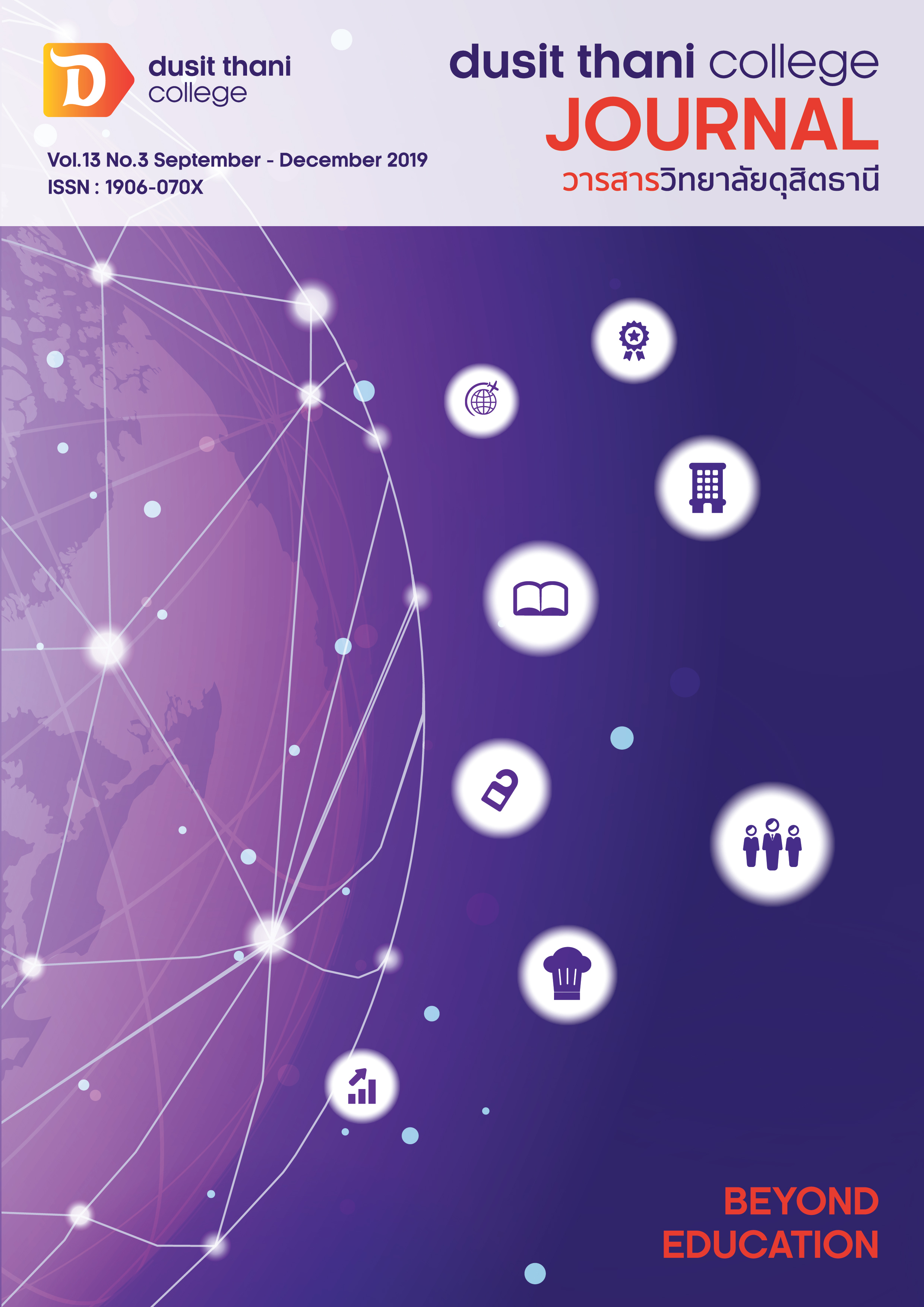ทัศนคติของประชาชนที่มีต่อผลกระทบทางสังคมกับการสนับสนุนการพัฒนาการท่องเที่ยวบนเกาะหลีเป๊ะ จังหวัดสตูล
Main Article Content
บทคัดย่อ
การศึกษาครั้งนี้มีวัตถุประสงค์เพื่อศึกษาทัศนคติของประชาชนที่เป็นเจ้าบ้านต่อผลกระทบทางสังคมกับการสนับสนุนของประชาชนด้านการพัฒนาการท่องเที่ยวบนเกาะหลีเป๊ะ โดยใช้แบบสอบถามในการเก็บข้อมูลจากกลุ่มตัวอย่างที่เป็นประชากรที่อาศัยอยู่ในพื้นที่เกาะหลีเป๊ะ จำนวน 384 คน และใช้สถิติร้อยละ ค่าเฉลี่ย ค่าส่วนเบี่ยงเบนมาตรฐาน และการวิเคราะห์การถดถอยพหุคูณในการวิเคราะห์ข้อมูล
ผลการศึกษา พบว่า ประชาชนมีทัศนคติต่อผลกระทบทางสังคมเชิงบวกจากการพัฒนาการท่องเที่ยวบนเกาะหลีเป๊ะโดยรวมอยู่ในระดับ เห็นด้วย (ค่าเฉลี่ย 3.93) และมีทัศนคติต่อผลกระทบทางสังคมเชิงลบจากการพัฒนาการท่องเที่ยวบนเกาะหลีเป๊ะโดยรวมอยู่ในระดับ เห็นด้วย (ค่าเฉลี่ย 3.51) และพบว่า ประชาชนที่มีทัศนคติต่อผลกระทบทางสังคมทั้งเชิงบวกและเชิงลบฯ นั้นให้การสนับสนุนการพัฒนาการท่องเที่ยวบนเกาะหลีเป๊ะ
Article Details
นโยบายการพิจารณากลั่นกรองบทความ
- บทความวิจัยและบทความวิชาการทุกเรื่องที่จะได้รับการตีพิมพ์ต้องผ่านการพิจารณากลั่นกรองโดยผู้ทรงคุณวุฒิ (Peer Review) ในสาขาที่เกี่ยวข้อง จำนวน 3 ท่าน/บทความ
- บทความ ข้อความ ภาพประกอบและตารางประกอบที่ลงตีพิมพ์ในวารสารเป็นความคิดเห็นส่วนตัวของผู้เขียน กองบรรณาธิการไม่จำเป็นต้องเห็นด้วยเสมอไป และไม่มีส่วนรับผิดชอบใด ๆ ถือเป็นความรับผิดชอบของผู้เขียนแต่เพียงผู้เดียว
- บทความที่จะได้รับการตีพิมพ์จะต้องไม่เคยตีพิมพ์ เผยแพร่ที่ใดมาก่อน และไม่อยู่ระหว่างการพิจารณาของวารสารฉบับอื่น หากตรวจสอบพบว่ามีการตีพิมพ์ซ้ำซ้อน ถือเป็นความรับผิดชอบของผู้เขียนแต่เพียงผู้เดียว
- บทความใดที่ผู้อ่านเห็นว่าได้มีการลอกเลียนหรือแอบอ้างโดยปราศจากการอ้างอิง หรือทำให้เข้าใจผิดว่าเป็นผลงานของผู้เขียน กรุณาแจ้งให้กองบรรณาธิการวารสารทราบจะเป็นพระคุณยิ่ง
เอกสารอ้างอิง
2. ASTV MGR. (2014). Travel Trail “Trash Hero Thailand” Conqueror of Koh Lipe. Retrieved from http://www.manager.co.th/FeelGood/ViewNews.aspx?NewsID=9570000123474 on 8th April 2015. (in Thai)
3. Beeton, S. (2006). Community development through tourism. Coolingwood, Australia: Landlinks
4. Bjorklund, E. M., & Philbrick, A. K. (1972). Spatial configurations of mental process. London.
5. Butler, R. W. (1974). “Tourism as an agent of social change.” Annals of Tourism Research, 2, 100–111.
6. Choi, H. C., & Murray, I. (2010). Resident attitudes toward sustainable community tourism. Journal of Sustainable Tourism, 18(4), 575–594.
7. Deery, M., Jago, L., & Fredline, L. (2012). Rethinking social impacts of tourism research:
A new research agenda. Tourism Management, 33(2012).
8. Dyer, P., Gursoy, D., Sharma, B., & Carter, J. (2007). Structural modelling of resident perceptions of tourism and associated development on the Sunshine Coast. Australia. Tourism Management, 28(2), 409–422.
9. E-library My First Info. (2015). Search News Lipe. Retrieved from http://www.myfirstinfo.com/thaidata/news/default.aspx on 8th April 2015. (in Thai)
10. Griffin, J. (2013). Local Residents’ Responses to Tourism as a Framework to Understand Hosts’ Responses to Short-Term Missions. The Asbury Journal, 68(2), 134–159.
11. Gursoy, D., Chi, C. G., & Dyer, P. (2010). Locals’ Attitudes toward Mass and Alternative Tourism: The Case of Sunshine Coast, Australia. Journal of Travel Research, 49(3), 381–394.
12. Haralambopoulos, N., & Pizam, A. (1996). Perceived Impacts of Tourism: The Case of Samos. Annals of Tourism Research, 23(3), 503–526.
13. Ko, D. W., & Stewart, W. P. (2002). A structural equation model of residents’ attitudes for tourism development. Tourism Management, 23(5), 521–530.
14. Lee, T. H. (2013). Influence analysis of community resident support for sustainable tourism development. Tourism Management, 34, 37–46.
15. Long, P. H., & Kayat, K. (2011). Residents’ perceptions of tourism impact and their support for tourism development: the case study of Cuc Phuong National Park, Ninh Binh province, Vietnam. European Journal of Tourism Research, 4(2), 123–146.
16. Maslow, A. H. (1954). Motivation and personality ([1st ed.].). New York: Harper.
17. Mcgehee, N. G., & Meares, A. C. (1998). A case study of three tourism-related craft marketing cooperatives in Appalachia: Contributions to community. Journal of Sustainable Tourism, 6(1), 4–25.
18. MGR Online. (2014). Native teacher implore all sector focus on student more than island development. Retrieved from http://www.manager.co.th/south/ViewNews.aspx?
NewsID=9570000104160 on 8th April 2015. (in Thai)
19. Ministry of Tourism and Sports. (2011). The national development plan for tourism 2012-2016. Ministry of Tourism and Sports. (in Thai)
20. Ministry of Tourism and Sports. (2015). Thailand Tourism Strategy 2015-2017. Ministry of Tourism and Sports. (in Thai)
21. National Geographic. (2012). Best Trips 2012. Retrieved from http://www.nationalgeographic.com/travel/best-trips-2012/ on 8th of April, 2016
22. Nunkoo, R., & So, K. K. F. (2016). Residents’ Support for Tourism: Testing Alternative Structural Models. Journal of Travel Research, 55(7), 847– 861.
23. Office of the Royal Development Projects Board. (2009). English Language Promotion Program on Koh Lipe. Retrieved from http://km.rdpb.go.th/Project/View/8425 on 8th April 2015. (in Thai)
24. Personal Social and Humanities Education Section Education Bureau. (2009). Manual on Module I Introduction to Tourism. Hongkong.
25. Planning and Budget Division. (2016). Development Strategies of Local Administration,
Satun Province (2018-2021). Satun Provincial Administrative Organization. (in Thai)
26. Pratkanis, A. R., Breckler, S. J., & Greenwald, A. G. (1989). Attitude Structure and Function. New Jersey: LAWRENCE ERIBAUM ASSOCIATES.
27. Prayag, G., Hosany, S., & Odeh, K. (2013). The Role of Tourists’ Emotional Experience and Satisfaction in Understanding Behavioral Intentions. Journal of Destination Marketing & Management. Retrieved from https://doi.org/http://dx.doi.org/10.1016/j.
jdmm.2013.05.001i, 17.03.2014 on 8th of April, 2016
28. Postma A. and Schmuecker D., (2017) “Understanding and overcoming negative impacts of tourism in city destinations: conceptual model and strategic framework”,
Journal of Tourism Futures, 3(2), 144-156,
29. Rasoolimanesh, S. M., Jaafar, M., Kock, N., & Ramayah, T. (2015). A revised framework of social exchange theory to investigate the factors influencing residents’ perceptions.
Tourism Management Perspectives, 16(2015), 335–345.
30. Resource Management for Sustainability (3r) Foundation. (2017). The project was initiated by Her Royal Highness Princess Maha Chakri Sirindhorn, Sustainable waste management in Koh Lipe. Retrieved from http://www.3rfoundation.or.th/th/SOCIAL ACTIVITIES/ PROJECT/ROYAL PROJECT/detail/185/ on 8th April 2015. (in Thai)
31. Spot cool Stuff. (2009). Thailand’s Best Islands. Retrieved from http://travel.spotcoolstuff.com/thailand/best-islands#lipe on 8th of April, 2016
32. Silpcharu, Thanin. (2014). Statistical analysis and research with SPSS and AMOS (15th edition). Bangkok: Business R&D.
33. Touropia. (2013). 10 Best Islands in Thailand. Retrieved from http://www.touropia.com/best-islands-in-thailand/ on 8th of April, 2016
34. Tovar, C., & Lockwood, M. (2008). Social impacts of tourism: an Australian regional case study. International Journal of Tourism Research, 10(4), 365–378.
35. United Nations Environment Programme, & World Tourism Organization. (2005). MAKING TOURISM MORE SUSTAINABLE: A GUIDE FOR POLICY MAKERS. Retrieved from http://www.unep.fr/shared/publications/pdf/DTIx0592xPA-TourismPolicyEN.pdf on 20th of May, 2016


